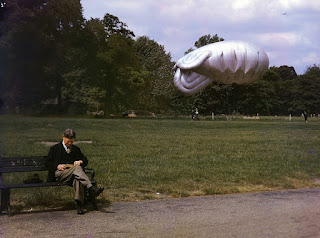The search for evidence of Grandad's early life continues, but recently I made a couple of discoveries which I will write about in two separate blog posts. This post is about a medal I found, and the following one will be about a previously-forgotten photograph.
The story begins with my daughter Tammy coming out from England in September and asking to look for the ring my mother left her. Putting aside an afternoon at the end of her visit, we took out all the boxes I had stored containing my parents' special items. Tammy found the ring and a couple of gold wristwatches, well-worn but still very pretty, which I put aside to have checked by our jeweller. Then we proceeded to look through the other trinkets in the box to see what else was there. The last time we had gone through the trinkets was when we had been sorting my mother's possessions after she died, and that was eleven years ago.
Tammy came across what looked like a very old metal shield. It was difficult to read the inscription on it but she eventually succeeded. It said: "King's Medal, Awarded by the London County Council for punctual attendance, 1910-1911". The name "David Scott Ritchie" was also inscribed on the reverse of the medal, although it was extremely faint.
This was an Amazing find, since we have no other artefacts relating to Grandad's schooldays. In 1910 he would have been eight years old! The medal had been presented to him in his second or third year of school, and the fact that he attended regularly said a lot about his stable life at the time.
Tammy looked up the provenance of school attendance medals and learnt that they had been manufactured in several versions. Originally, they bore the name and face of Queen Victoria, then King Edward VII, then King George V. Grandad's King's Medal showed King George V on its face. It was presented by the London County Council to all children who attended school regularly, but only children with a 100% attendance record for the school year and whose behaviour was considered commendable by the headmaster qualified to receive it.
Apparently, the medal came with an orange ribbon but Grandad's medal had lost that, no doubt due to rough handling over the 110 years since it was awarded! I like to think of Grandad being proud of his achievement and of him holding onto the trinket as a reminder of his early years at school.
I took the medal, along with Mom's two gold wristwatches, to our jeweller for cleaning. Imagining that the King's Medal would come up shiny and new-looking, I was disappointed when I was told it couldn't be polished. Apparently, the metal they used was ordinary tin, or something like it, so any attempt to polish it would probably damage it. Later, when Tammy visited again, she looked at the object I had taken to the jeweller and pronounced my mistake; I had taken an ordinary belt buckle, so it was no wonder the jeweller was confused about my claim that it was a family heirloom. Fortunately, there was no need for us to search in the boxes for the actual King's Medal because Tammy had images of it on her phone from when we had shared the discovery with my aunt and cousins. Maybe I could still get it polished, but the images are fine for now!
While the discovery of a school attendance medal cannot replace a birth certificate as proof that Grandad was born in England, it certainly adds something to the story. We know from the 1911 census that Grandad was at the home of his aunt and uncle, Emily and William Smith, on the night the census was taken. From what I have found out about his parents [see other posts about his father, David Scott Ritchie Sr and his mother, Maude], I feel certain that he was living with the Smiths permanently. From what I have learned about the Smith children and grandchildren, it appears that Emily and William placed a high value on education. So then, while the medal awarded to the nine-year-old David doesn't tell us how he became an engineer, it does satisfy my curiosity about how he avoided the long-term effects of having a mentally-ill father and a mother who worked as a cook in residence for aristocratic families. Thanks to the Smiths of St Johns Wood, my grandmother Sandy, mother Wendy, aunt Gillian and all their descendants benefitted from a stable home life, optimism about the future, and a sense of responsibility that translated itself into a sound work ethic and professional success.
Photo: Grandad's medal for good attendance at school..







